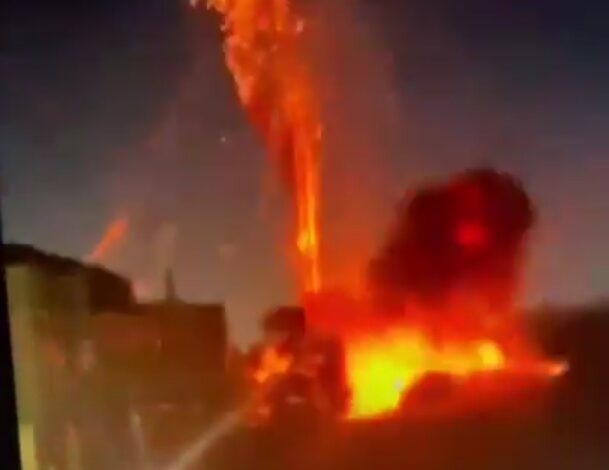
Helicopter Crash in Houston, Texas: Fatal Collision with Radio Tower Claims Lives and Disrupts Communications, Ongoing Investigation Seeks Answers After Devastating Incident Leaves Community in Mourning”
Helicopter Crash in Houston, Texas: Fatal Collision with Radio Tower Claims Lives and Disrupts Communications, Ongoing Investigation Seeks Answers After Devastating Incident Leaves Community in Mourning”
In a devastating incident that has shocked the Houston, Texas, community, a helicopter crashed into a radio tower, resulting in multiple fatalities and significant damage to the city’s communications infrastructure. The tragic event occurred around midday, transforming an ordinary day into a scene of chaos and grief. Emergency services were immediately called to the site, but by the time they arrived, the wreckage was scattered across the area, with the mangled remains of the helicopter and parts of the radio tower entangled. Authorities quickly sealed off the location, and rescue teams scrambled to manage the dangerous scene while assisting any possible survivors.
The helicopter, a privately owned aircraft, was on a routine flight before the accident took place. Initial reports suggest that the helicopter, carrying a pilot and at least one passenger, experienced some form of mechanical difficulty moments before the crash. Eyewitnesses reported seeing the helicopter struggling to maintain stability in the air before veering off course and colliding with the towering structure. The impact resulted in a section of the radio tower collapsing, sending debris raining down on the surrounding area. Emergency responders were met with a harrowing sight as they worked to retrieve the bodies of those on board, who were pronounced dead at the scene.
Investigations into the cause of the crash are currently underway, with the Federal Aviation Administration (FAA) and the National Transportation Safety Board (NTSB) leading the efforts. A preliminary analysis is considering multiple potential causes, such as pilot error, mechanical failure, or external factors like weather conditions. Although the weather at the time of the incident was generally clear, unexpected gusts of wind or other environmental factors have not been ruled out as contributing elements. The crash has left investigators with a challenging task, as both the helicopter’s flight data and communication records need to be thoroughly examined to reconstruct the final moments before the collision.
The radio tower that was struck plays a significant role in Houston’s communications network, serving as a hub for both local radio stations and emergency response communications. The damage to the tower has raised concerns about the impact on local communication services, although authorities have reassured the public that backup systems are in place to minimize disruptions. Nevertheless, the extent of the damage to the tower itself means that repairs will likely take some time, and the potential for temporary communication blackouts remains a concern for officials and residents alike.
Families of the victims are in mourning, struggling to comprehend the sudden loss of their loved ones. Authorities have not yet released the identities of the deceased pending notification of their next of kin. The tragedy has left a deep impact not only on the immediate families but also on the broader Houston community, with many expressing their shock and sadness at the event. As condolences pour in, friends, colleagues, and local community members are coming together to provide support to the grieving families. Memorials are being planned, and the victims will be remembered for the lives they lived before this untimely and heartbreaking end.
As part of the investigation, a detailed inspection of the helicopter’s maintenance history is being conducted to determine if there were any prior mechanical issues that could have contributed to the crash. The aircraft, a light utility helicopter commonly used for private flights, was reportedly well-maintained, but the investigation will scrutinize all records, including recent maintenance and any repairs carried out in the days leading up to the flight. Pilot training records will also be reviewed to understand the experience level of the person in control at the time of the crash.
The helicopter crash has ignited a discussion on flight safety, particularly in urban areas where high-rise structures, including radio towers, pose a potential hazard for low-flying aircraft. Although aviation experts point out that such accidents are relatively rare, the incident has sparked concerns about existing safety protocols and whether additional measures should be taken to prevent similar occurrences in the future. Some aviation analysts suggest that flight paths over urban centers should be re-evaluated, while others advocate for more stringent regulations regarding maintenance checks and pilot certifications for urban flights.
The tragedy has also impacted the broader community beyond just the families and friends of the victims. With part of the radio tower collapsing during the crash, the incident disrupted local communications, including public safety radio frequencies, making it more challenging for first responders to coordinate their efforts. While alternative communication methods were quickly activated to restore emergency services, the temporary disruption highlighted the vulnerability of the infrastructure and the need for comprehensive backup systems to ensure seamless communication during crises.
Houston, known for its resilience in the face of adversity, has come together to support those affected by the crash. Local officials have praised the rapid response of emergency services, while also acknowledging the need to learn from the incident to improve safety measures in the future. The crash serves as a sobering reminder of the risks associated with aviation and the need for continuous advancements in safety protocols. The FAA and NTSB have stated that they are committed to a thorough investigation, and their findings will likely inform future policy changes aimed at preventing such tragedies from occurring again.
As more details emerge, the investigation’s findings will hopefully bring some closure to the families of the victims and help ensure that the lessons learned from this tragic event lead to meaningful changes in aviation safety. In the meantime, the focus remains on supporting the grieving families and addressing the broader implications of the incident for the community and aviation industry.



